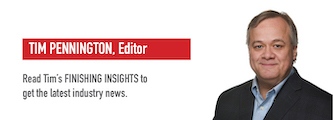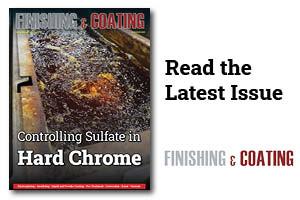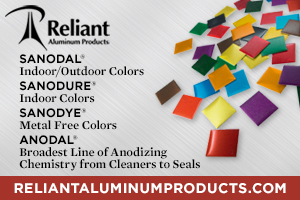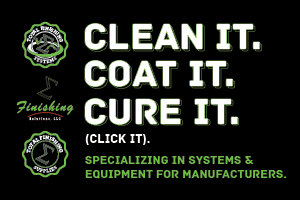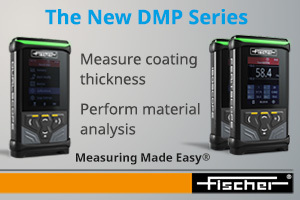Next to air, water is the most important ingredient for life. Now consider that it’s also the main ‘chemical’ used in the plating bath.
 Eric Svenson Sr.Its purity is essential for trouble-free hard chrome plating. Water purity should never be taken for granted. Purified water is preferred for new bath make-ups, rinsing, and replacing evaporative losses in the tanks.
Eric Svenson Sr.Its purity is essential for trouble-free hard chrome plating. Water purity should never be taken for granted. Purified water is preferred for new bath make-ups, rinsing, and replacing evaporative losses in the tanks.
Municipal water supplies are the typical source for plating operations, although some shops have used well water as an alternative. The quality of municipal water varies considerably across the USA. Most city waters are pretreated, which would lead one to assume the various impurities are within acceptable ranges. However, this is rarely the case, especially for those operations that recycle their rinse water and ventilation wash-downs.
Just because a water supply has been approved for drinking doesn’t mean that it’s ideal for hard chrome plating. In fact, many of the impurities are much higher than what’s desirable for quality chrome deposits and reduced operating costs.
These impurities accumulate in the chrome bath until their concentration reaches a level at which the plating quality is compromised. The bath then either needs a treatment or the bath must be replaced. That operation is poisoning their tanks every time water is added. Using well water is even worse because it’s overloaded with metallic and non-metallic ions.
It’s both desirable and cost-effective to use a water purification system for the plating operation. This should be designed to remove all harmful ions and prevent their build-up in the plating baths.
Impurity Limits
Several items contribute to the quality of the water used. The following are the five most critical concerns. The water purification system should provide ionic levels below these upper limits.
- Component: Maximum
- Chloride, ppm (Cl): 5.0
- Copper, ppm (Cu): 1.0
- Fluoride, ppm (F): 1.0
- Iron, ppm (Fe): 1.0
- Sulfate, ppm (SO4): 2.0
Overall, there are 20 impurities of concern, including pH, TDS, organics, conductivity, and many others. These can be obtained by contacting the person at the end of this article.
Primary Concerns
The most objectionable ions are those that catalyze the electrolyte. These include chlorides, fluorides, and sulfates. The chloride and fluoride ions, unless present in high concentrations, are not the most critical because they evolve at the anode surface during electrolysis. This usually keeps them within tolerable limits.
The sulfate, iron, and copper ions in the water supply are a different story and are the most critical. In chromium plating, the sulfate ion acts as a true catalyst; it is not consumed during the plating operation. Any amount of sulfate in the water supply will increase its concentration in the bath, thereby lowering the ratio of chromic acid. This affects the plating quality and requires frequent treatments with barium carbonate. Barium treatments should be avoided whenever possible due to the associated hazards and waste issues. It’s also a messy and costly approach that’s only a temporary fix that will have to be repeated many times when the sulfate level increases again.
Likewise, any iron or copper in the water supply will continually build up in the plating bath. These metals do not plate out and only increase in concentration, which poisons the bath to the point where a costly dump and replacement are needed.
Water Testing
Hard chrome operations should test their water supply to ensure it meets the purity requirements. This testing can be arranged by contacting the information below. A sample should be taken from the cold-water supply in the same pipe that’s used to supply the plating operation. A new and clean polyethylene bottle and cap should be used to provide a 250 ml sample. It’s recommended to allow the cold water to flow for 1 - 2 minutes, then flush the bottle and cap several times to provide a representative sample that isn’t contaminated. A detailed analysis is usually provided in a couple of weeks, which includes various recommendations.
An estimate of the daily water usage requirement should also be determined. This volume (in gallons) can be calculated directly from the water supply bill for operations where a bulk of the water used is in the plating shop.
Water Purification
Several methods are used to purify city water suitable for the plating operation. The most economical and effective combination is a combination of Reverse Osmosis (RO) and Deionization (DI). Activated carbon filtration can be used to remove organics, and ultraviolet light can be employed to kill any microbial growth if present.
The plant water should first be run through a 5-micron filter, then through the RO system, and finally through the DI system. RO is used as the first treatment because it removes a bulk of the impurities without expending the DI resin. This also reduces the size and cost of the DI (ion exchange) system, as well as the frequency of regenerating the DI resins. Depending on the water analysis, a mixed bed (anionic and cationic) resin is incorporated in the DI system.
The treated water can be either direct-fed to the plating system or stored in a pressurized tank. The pressurized tank is generally preferred because it can provide large volumes of purified water quickly when needed. This also allows for a smaller and less costly purification system because of the reduced flow rate involved. A typical system would provide a minimum of 50 psig of water pressure with a flow rate of 25 gpm.
The system should include a manual water shut-off valve installed on the incoming water supply, placed for easy access by workers. This allows the operators to turn it off at the end of each workday to prevent a water leak that could overflow the tanks and cause a devastating environmental issue.
The investment required for these systems typically runs between $10,000 $50,000 or more, depending on the purification requirements and the volume of water needed. On the surface, this may appear expensive, but it is actually considered a good and valid investment, considering the costly problems it prevents.
These systems can be purchased outright or set up on a lease program. Most suppliers offer the services necessary to maintain their water purifiers, although some operations prefer to handle this task internally.
DI Resins
 Typical DI Resin Bottles.The DI portion of the system utilizes an anionic, cationic, or mixed-bed resin, which is selected based on the water impurities identified in the analysis. The anions include substances such as chlorides, fluorides, and sulfates. Cations include calcium, magnesium, iron, and copper, among others.
Typical DI Resin Bottles.The DI portion of the system utilizes an anionic, cationic, or mixed-bed resin, which is selected based on the water impurities identified in the analysis. The anions include substances such as chlorides, fluorides, and sulfates. Cations include calcium, magnesium, iron, and copper, among others.
These resins have a finite ability to ‘absorb’ the impurities and eventually require regeneration. This strips impurities from the resin, allowing it to be reused. These resins are fairly expensive, so regeneration makes economic sense.
The regeneration frequency is dependent upon the type of impurities in the water, their concentrations, and the flow rate through the system. Anionic resins are regenerated using an alkali solution like sodium hydroxide, while cationic resins are regenerated using a strong sulfuric or hydrochloric acid solution. The need for regeneration is indicated by a conductivity meter or light.
Regeneration can be performed in-house as part of the system or by the supplier, who simply exchanges the DI cylinders for fresh ones. The supplier then handles this task off-site. The DI cylinder exchange seems to be the most popular choice for many operations.
Regeneration Cautions
The regeneration process requires backwashing the resin column to remove the trapped impurities. This involves pumping a regenerator, either alkali or acid, through the resin column. A slow DI water rinse follows this step to remove a bulk of the regenerate, and finally, a fast DI water flush serves as a final polishing step.
The problem is when any of the regenerate, alkali, or acid is used and hasn’t been completely flushed out of the resin. This causes them to enter the plating bath the next time that resin bed is used. This can be an issue with off-site vendors who might rush the regeneration process. The worst situation is where any amount of hydrochloric or sulfuric acid used for regeneration later enters the bath. The limit for chlorides in the chrome bath is only 20 ppm, and any amount of sulfate will quickly upset the ratio. Both of these issues will affect the quality of the plating deposit.
Therefore, it’s highly recommended that the water quality from any DI regeneration be tested for both chlorides and sulfates before that water is used in the process. Fortunately, there is a qualitative test available that takes only 2-3 minutes. This simple test can save endless headaches and costs. Information on this testing can be obtained from the contact listed below.
Improving Your Water Supply
Plating Resources, Inc. can provide water analysis and make recommendations for the design and sizing of the purification system. It’s generally recommended that these systems be obtained directly from a local vendor that also provides resin regeneration and any necessary maintenance requirements. Investing in a water purification system provides rewards for years to come. Improved bath chemistry, enhanced chrome deposit quality, reduced maintenance issues, and lower processing costs evidence this.
Eric Svenson Sr. is CEO of Plating Resources and a Master CEF and IUSF member. Visit www.Plating.com. If you have any questions or wish to explore this topic further, please contact Vicky at Vicky@Plating.com.




